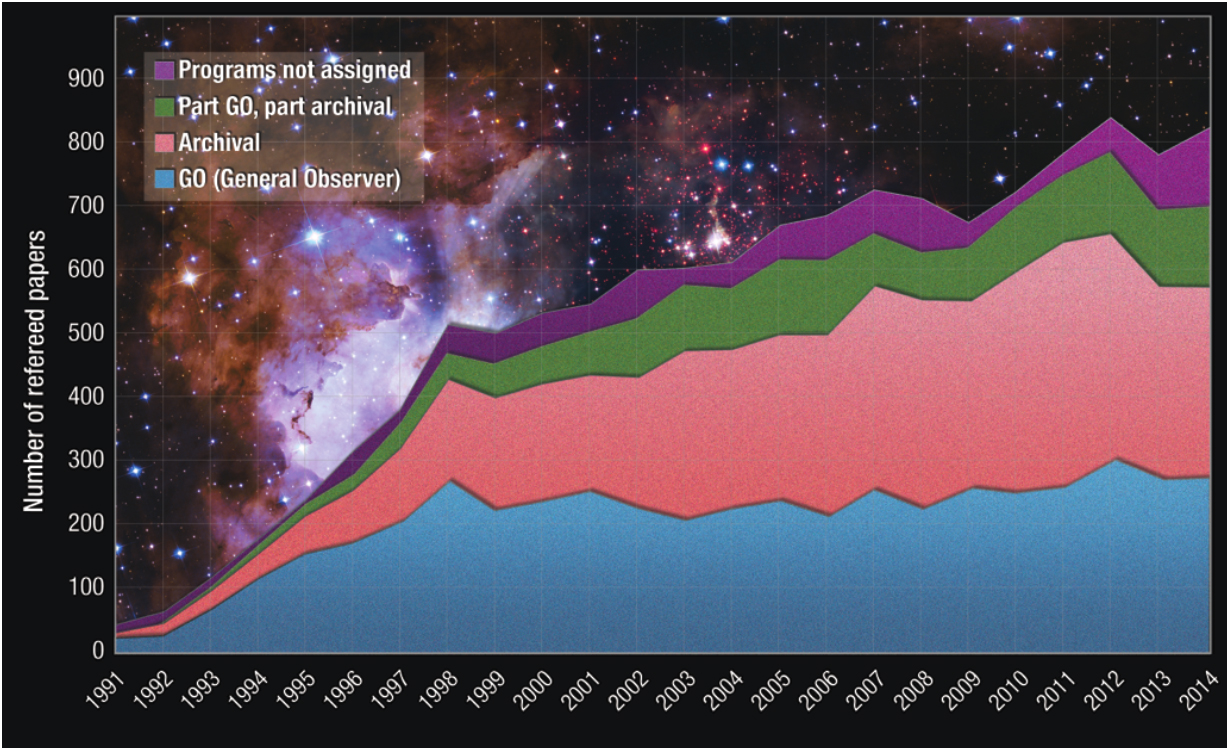Editorial
Dear Colleagues,
The recent public release of the European Hubble Archive (eHST) has inspired me to share my own thoughts on the extraordinary advantages that a mission archive offers, both to the professional community and to the public at large; especially if the mission has gathered observations for more than 25 years.
At the present time, approximately half of the refereed publications based on Hubble observations are derived purely from archival data (Figure 1), and, every year, this number is slightly higher than the number of publications based on new observations. Because of the long mission baseline, the Hubble Archive has become a goldmine for the astronomical community. As new observations are routinely added, the breadth of their potential utilisation expands constantly, creating a unique resource for astronomers to exploit for statistical studies, comparison analysis, monitoring of transient phenomena, and many other clever applications. European astronomers have been particularly creative and successful in their use of the Hubble Archive, demonstrated by the fact that roughly half of the total Hubble archival publications are led by European authors.
The importance of the archive to European astronomers in particular is the rationale behind the development and release of the new eHST. The eHST features a new, user-friendly interface designed to make access to the Hubble data easy and efficient, and will serve as a robust companion to the Hubble Archive at the STScI. The Hubble Legacy Archive (HLA) and the release of the Hubble Source Catalog (HSC) have laid a path for easier and more effective access to Hubble data and related information; the eHST is the next natural step along this roadmap. You can find information on the recent eHST release in this newsletter.
At the moment of writing, the eHST contains about 100 TB of data, and about 1 million observations. Some targets within the archive have been observed multiple times, and this has prompted thoughts on how best to exploit this wealth of data. In a collaborative effort between ESA/ESAC, STScI and the National Observatory of Athens, ESA is funding the development of a Hubble Catalog of Variables (HCV) that will become available to the community in 2018. Additional information on the HCV can be found in the related article in this newsletter.
Finally, I would be remiss not to mention the incredible value of an archive such as Hubble’s to the public at large. It is difficult, as professional astronomers, to imagine the value and impact that an astronomical archive can have for the general public. At least, we had no idea before 2010… Then, ESA/Hubble ran the Hubble Hidden Treasures competition and challenged the public to dig into the Hubble Archive and retrieve previously unknown beautiful images of observed astronomical objects. We were totally blown away by the response: more than 3000 entries were submitted! Not only a myriad of stunning images emerged, but amateur astronomers, students, professionals and teachers invested significant time and effort to make these images beautifully ready for prime time. Our Picture of the Week selection still draws from the pool of images generated by the competition, all of which are breathtaking and were previously totally unknown.
In summary, the archive is an essential part of the scientific exploitation of a mission, and I hope that I have convinced you that the investment of resources in making data archives accessible, agile and easy to use brings a huge return in terms of additional community involvement, scientific results and public wonder. Well worth it!
Finally, we are offering two exciting opportunities to become part of the ESA Hubble team. If you are interested in joining the team based at STScI in Baltimore, USA, then please consider applying for one of the two ESA/AURA astronomer positions currently open to applicants. These positions, funded by ESA, are for a three-year contract, with the possibility of renewal, and offer the opportunity to be at the forefront of ESA’s work with Hubble. For more information visit the application page or contact me.

The Hubble Archive is a goldmine for astronomers, as shown. Credit: ESA, NASA

|
21 October 2015: A supernova is a stellar explosion that can briefly outshine an entire galaxy, radiating as much energy as the Sun is expected to emit over its entire lifespan, before fading from view over several weeks or months. Supernovae occur approximately once a year per galaxy, meaning that it is not impossible for several to be found when observatories with very ...
|
| Read more |